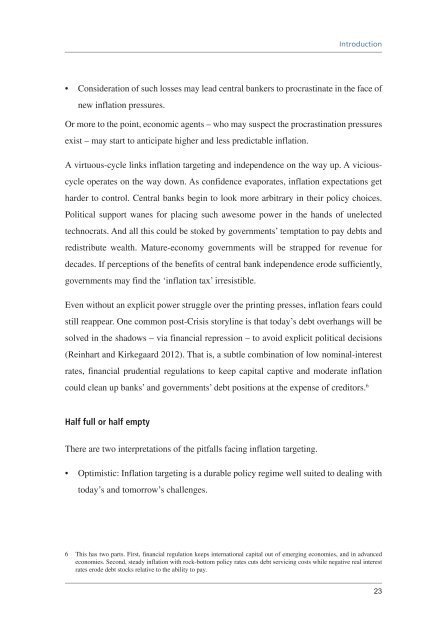You also want an ePaper? Increase the reach of your titles
YUMPU automatically turns print PDFs into web optimized ePapers that Google loves.
Introduction• Consideration of such losses may lead central bankers to procrastinate in the face ofnew <strong>inflation</strong> pressures.Or more to the point, economic agents – who may suspect the procrastination pressuresexist – may start to anticipate higher and less predictable <strong>inflation</strong>.A virtuous-cycle links <strong>inflation</strong> <strong>targeting</strong> and independence on the way up. A viciouscycleoperates on the way down. As confidence evaporates, <strong>inflation</strong> expectations getharder to control. Central banks begin to look more arbitrary in their policy choices.Political support wanes for placing such awesome power in the hands of unelectedtechnocrats. And all this could be stoked by governments’ temptation to pay debts andredistribute wealth. Mature-economy governments will be strapped for revenue fordecades. If perceptions of the benefits of central bank independence erode sufficiently,governments may find the ‘<strong>inflation</strong> tax’ irresistible.Even without an explicit power struggle over the printing presses, <strong>inflation</strong> fears couldstill reappear. One common post-Crisis storyline is that today’s debt overhangs will besolved in the shadows – via financial repression – to avoid explicit political decisions(Reinhart and Kirkegaard 2012). That is, a subtle combination of low nominal-interestrates, financial prudential regulations to keep capital captive and moderate <strong>inflation</strong>could clean up banks’ and governments’ debt positions at the expense of creditors. 6Half full or half emptyThere are two interpretations of the pitfalls facing <strong>inflation</strong> <strong>targeting</strong>.• Optimistic: Inflation <strong>targeting</strong> is a durable policy regime well suited to dealing withtoday’s and tomorrow’s challenges.6 This has two parts. First, financial regulation keeps international capital out of emerging economies, and in advancedeconomies. Second, steady <strong>inflation</strong> with rock-bottom policy rates cuts debt servicing costs while negative real interestrates erode debt stocks relative to the ability to pay.23



